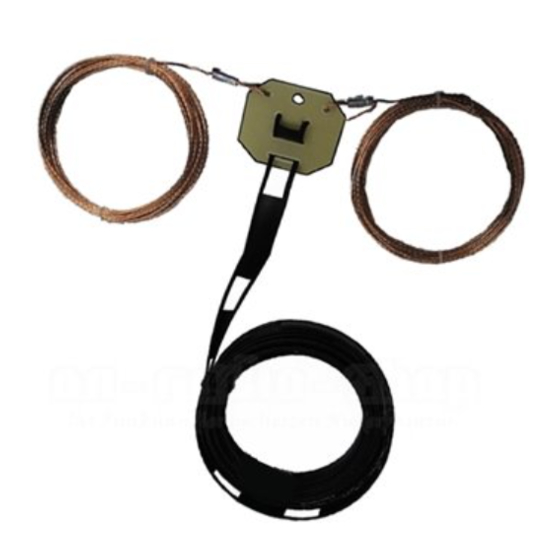
Table of Contents
Advertisement
Quick Links
MFJ All Band Doublet
Instruction Manual
MFJ-1777 All Band Doublet
INTRODUCTION
The MFJ-1777 is a multi-band center-fed dipole antenna capable of handling
1500 watts. It consists of a 102-foot "flat top" antenna fed with a length of 450
ohm balanced "ladder line."
This antenna requires the use of a suitable matching network (antenna tuner)
with provisions for balanced-feed antennas, for interface with the 50-ohm
unbalanced antenna outputs of modern transceivers and amplifiers.
This antenna will work as supplied, as a centerfed antenna, on all amateur bands
80 through 10 Meters. On 160 Meters it can be used as top loaded vertical
antenna, with the dipole element acting as a capacitance hat on 160 meters (see
"160 Meter Operation," page 3). Operation on 160 Meters in this manner
requires a ground screen or radial ground system, which is discussed on page 4.
This antenna will not work effectively in its center-feed configuration on 160
Meters.
TOOLS AND TIME REQUIREMENTS
This antenna requires no assembly. The time needed for installation will vary
with your skill and equipment. No special tools are required to install this
antenna. Nylon ropes are needed to support the ends of the antenna from
suitable structures or trees If trees are used, you will need a way to get ropes
over it. The most common method is to use a weighted arrow or a fishing rod
and a sinker to place a small line over a tree. A larger line is then pulled up and
used to pull the support rope over the tree. The ARRL Antenna Handbook has
detailed suggestions for installing wire antennas.
WARNING: Always mount antennas so that they are out of
the reach of adults and children. Contact with any part of
this antenna can cause RF burns or other injuries.
See the Safety Precautions on page 7.
1
Advertisement
Table of Contents

Subscribe to Our Youtube Channel
Summary of Contents for MFJ MFJ-1777
- Page 1 Instruction Manual MFJ-1777 All Band Doublet INTRODUCTION The MFJ-1777 is a multi-band center-fed dipole antenna capable of handling 1500 watts. It consists of a 102-foot “flat top” antenna fed with a length of 450 ohm balanced “ladder line.” This antenna requires the use of a suitable matching network (antenna tuner) with provisions for balanced-feed antennas, for interface with the 50-ohm unbalanced antenna outputs of modern transceivers and amplifiers.
- Page 2 MFJ All Band Doublet Instruction Manual INSTALLING THE ANTENNA The best location for this antenna is as high and far away as possible from utility wires, other antennas, and other structures. It is difficult to find a perfect location, so the best compromise usually must be accepted. The antenna can be...
- Page 3 45 degrees and almost vertical. 160 METER OPERATION AND GROUNDING The MFJ-1777 will can be used on the 160 meter band as a “Marconi Antenna.” Operation on 160 requires a tuner and a good RF ground system. Do not try to use this antenna in its supplied, center-feed configuration on 160 Meters, as you risk damage to your antenna tuner and/or transceiver.
- Page 4 If you have a tuner that tunes only unbalanced, 50- ohm loads (such as the internal tuner in some transceivers) it is still possible to use this antenna. Connect a suitable 4-to-1 current balun (such as the MFJ-912 “W9INN Balun Box”) between your balanced feedline and your transceiver through a short piece of 50-ohm coax.
- Page 5 MFJ Technical Service at 662-323- 0549 or the MFJ Factory at 662-323-5869. You will be best helped if you have your unit, manual and all information on your station handy so you can answer any questions the technicians may ask.
- Page 6 MFJ All Band Doublet Instruction Manual SAFETY PRECAUTIONS • This antenna is an electrical conductor. Contact with power lines can result in death or serious injuries. Do not install this antenna where there is any possibility of contact with power cables or the service drop. The antenna should not be close to power lines during installation, operation, or removal.













Need help?
Do you have a question about the MFJ-1777 and is the answer not in the manual?
Questions and answers